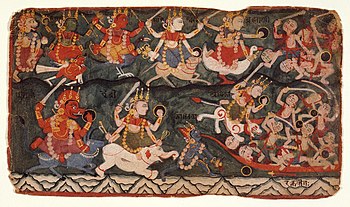Because Nepal sits in between two major Asian
cultures—Indian and Tibetan—it would make sense that Nepal’s cultural arts
share many of these cultural identifications along with new styles that merge
both cultures.
The majority of the ancient artifacts we have today
came from the Newa people. The Newa people were known for their religious art
(pretty much all of the examples of their art are religious based). Among some
of their mediums they used were paintings, metal work, and sculpture. Most of
the paintings were paubha paintings, which were paintings that depicted various
deities or religious objects or scenes and used for meditation. Sandpainting
mandalas were something that Buddhist monks are known for. Other types of
sculpting, like stone sculpting and wood carving, were also highly popular.
Repoussé art is where the artist hammers out designs in super malleable metal.
As Nepal came in contact with Western cultures,
many of their artistic styles stayed with them. As artists learned various
styles, they would introduce it to other Nepali artists. Raj Man Singh
Chitrakar is often credited to introducing watercolor painting and making it
popular. Other artists who were instrumental in bringing different styles and
genres to Nepal include Chandra Man Singh Maskey, Bhaju Man Chitrakar, and Tej
Bahadur Chitrakar.
The traditional architecture of Nepal is centered
around practicality and functionality as well as aesthetics. Pagodas are
generally common with Hindu temples, but it’s also used in Buddhist temples as
well. The number of layers can vary. Stupas are also commonly found in Nepal; a
stupa is a structure that typically holds the remains of Buddhist monks and
nuns. It can be a place for meditation and is generally a dome shape, kind of
like Patrick Starr’s rock.
 |
| Nyatapola Temple in Bhaktapur, Nepal |
The National Museum of Nepal is one of the main
museums in the country, housing many of their national treasures and relics.
There are several sections of the museum, including one for Nepalese history
and the Art Gallery. This gallery includes many of the ancient works of art
going back to the first few centuries of this era.
A large portion of the literature coming from Nepal
is written in Nepali. It’s an old language related to Sanskrit. Bhanubhakta is
often considered the first producer of Nepali poetry, and really, Nepali
literature in general. We really don’t have any evidence of any writing in
Nepali before him, so he wins it by default. However, at that time, most of the
people who were literate enough to know how to write were the Brahmins and
upper crust of Indian society. Most of the people in Nepal wouldn’t have been
included in those circles according to some historians, so they consider
Suwananda Daas as the first. The time before their independence struggles and
their Civil War inspired a number of authors to use their talents as an
expression of their views and as an outlet for their creativity. Many short
stories, novels, and poetry were produced during this time. In fact, the
writers emerging since the 1990s have really pushed the styles and genres of
Nepali literature, and authors writing from abroad add an additional level to
Nepali literature.
 |
| Harry Potter in Nepali |
At the same time, there were works being written in
other languages. One of the other languages people wrote in was Newari
(sometimes referred to as Nepal Bhasa literature). Newari literature actually
pre-dates Nepali literature. Starting in the early 1500s, Newari lit took off,
and its Classical Period mainly consisted of various styles of poetry, short
stories, and drama. During the Rana dynasty (1846-1951), Newari literature
dropped off. Writers were often jailed for writing in Newari. Writers were also
arrested during the WWII years. Buddhist monks would often write in Newari and
were the subject of harassment by the government (and even some were exiled)
for teaching Buddhism and writing in the Newari language. During the 1960s, the
language underwent another blow when only one language was allowed (Nepali).
All others were banned. Today, it’s not quite as oppressive as it was, and
Newari literature serves as more of a niche genre.
Up next: music and dance




No comments:
Post a Comment